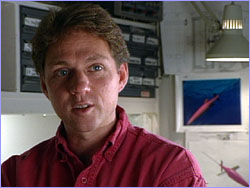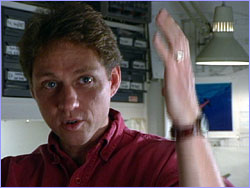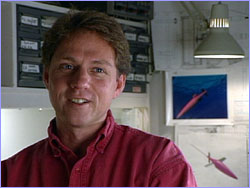
|
 |
 Hear Keith Shepherd via RealAudio: 28.8 | isdn software |
 Meet the Team:
Meet the Team:Keith Shepherd Keith Shepherd is General Manager of the Canadian Scientific Submersible Facility and pilots both manned submersibles and remotely operated vehicles (ROVs). On this cruise, he will pilot the ROV known as ROPOS. (ROPOS is an acronym for Remotely Operated Platform for Ocean Science.) Shepherd gave us his thoughts on the challenges he faces in using ROPOS to carve a black smoker chimney off the seabed using a diamond-studded chain saw. NOVA: How extreme are the conditions working in a hydrothermal vent field? Shepherd: There are many of thousands of pounds per square inch. For example, when we were working at full depth in the submersible Pisces IV, the pressure on the hatch alone was about 100,000 pounds. It's like having 20 pick-up trucks sitting on top of a hatch that's 14 inches in diameter. So you're really relying on good engineering to keep things together. And once we get into the hydrothermal areas, the chemicals coming out of the vents are very corrosive. Even stainless steel will disappear quite quickly once it's immersed in these plumes. All the equipment must be carefully maintained to resist these effects. NOVA: What is the terrain like down there? Shepherd: Some places where the lava has squirted out, it makes these big pillow shapes. Other places there's a lava lake where the lava has filled up and then solidified, and then the hot lava underneath has drained away and leaves this perfectly flat surface with some spires underneath. In some of these places, it collapses. So as you fly over these areas, you see these fields of chimneys and so on, sometimes still connected by a top crust and sometimes not. Then, in other places, there are large fissures where the Earth is split open. Some are very, very small and some are big enough to drive your submersible through and explore. NOVA: Is it tough driving a sub through a field of black smokers?  Shepherd: There are several things to watch out for.
There's hot water that is 300 to 400 degrees Celsius, and if
you put something in there you can burn or even melt it. And
as you move up and around the structure, there are different
types of animals growing in different places, and scientists
often like to sample these. It's quite challenging to hold the
submersible in a position and reach out with different
equipment and collect the animals, or take chemical or
temperature samples.
Shepherd: There are several things to watch out for.
There's hot water that is 300 to 400 degrees Celsius, and if
you put something in there you can burn or even melt it. And
as you move up and around the structure, there are different
types of animals growing in different places, and scientists
often like to sample these. It's quite challenging to hold the
submersible in a position and reach out with different
equipment and collect the animals, or take chemical or
temperature samples.You're very dependent on the ship holding the position. If the ship starts to wander off, then it can drag the whole works into cliff faces or other hazards. Finally, you always have to be aware of how you approached an object and where your tether is. You don't want to drive up to an object, then spin around the other side, then continue back around, because you can lasso it with your tether. NOVA: Is there always a risk that, once you put something overboard, you might not see it again? Shepherd: Every time you launch something at sea, there's always a risk that something can happen: a mechanical or electrical failure, or a weather problem. It's often said, if you don't want to lose it, don't put it over the side. NOVA: You lost an ROV once. What was that like? Shepherd: It was pretty devastating when we got caught in a storm and lost our ROV. The weather came up suddenly and unexpectedly, and before we could get the system back on deck, although everybody tried very hard to recover the submersible, the serious events, mostly due to the weather, caused some failures in the ship and difficulties getting lines on the sub, and so on. Eventually the tether parted, and it sailed away. The ship was damaged, so we couldn't chase after it. That was the last we saw of it. NOVA: How do you launch and operate the ROV? Shepherd: ROPOS works out of a cage, or a garage-type assembly, which simplifies launch and recovery. The A-frame of the ship picks up the cage and swings it out. As the cage hangs over the water, you pay out the winch, and the cage goes down towards the bottom. Just above the bottom the cage stops and the ROPOS swims out, with its tether connecting it to the cage. Then, if the ship is maneuvering and heaving up and down on the surface waves, then ROPOS, with its separate cable, is unaffected by the ship motion, which is important if you're doing delicate work and maneuvers on the bottom. NOVA: How does piloting an ROV differ from piloting a manned submersible? Shepherd: They're quite different. With an ROV you're in a room with dim lights and video monitors showing what's going on at the bottom. But you're surrounded by many people all doing a multitude of different tasks. That's one of the advantages of an ROV: you can have many people participating in it. And you can get up and have a cup of coffee and stretch your legs and shift off being a pilot. NOVA: Is using a chain saw for the first time on a black smoker risky?  Shepherd: It has an element of risk. We're using a
Stanley underwater chain saw. It's basically an off-the-shelf
tool that divers often use for doing work on piers and
concrete docks. It has carbide and diamond-embedded blocks in
the chain, and it has been adapted to go deep. We've tried to
reduce the risk by conducting sea trials. We've already had
the saw mounted on an ROV and deployed from a ship, and we've
successfully tested the saw on concrete structures—it
was incredible to see the saw cut through the concrete just
like a knife through butter—and even on a granite
cliff-face. We're pretty confident that if we cut into
granite, we should be able to cut these structures off.
Shepherd: It has an element of risk. We're using a
Stanley underwater chain saw. It's basically an off-the-shelf
tool that divers often use for doing work on piers and
concrete docks. It has carbide and diamond-embedded blocks in
the chain, and it has been adapted to go deep. We've tried to
reduce the risk by conducting sea trials. We've already had
the saw mounted on an ROV and deployed from a ship, and we've
successfully tested the saw on concrete structures—it
was incredible to see the saw cut through the concrete just
like a knife through butter—and even on a granite
cliff-face. We're pretty confident that if we cut into
granite, we should be able to cut these structures off.NOVA: Will cutting a black smoker chimney be as simple as cutting those blocks of concrete? Shepherd: The chimneys will introduce several different technical risks, as opposed to cutting a concrete box alongside a dock. The submersible has to be positioned properly, and the ship has to hold station. These structures have always had hot water pouring through them and, once we start to cut, we're not sure what's going to happen. We can get the saw blade in there and open up a new passage for the water to come out. Hot water can start squirting out around the saw blade and back towards the vehicle. I think we'll be far enough away that it won't be a problem, but it's something we'll be watching very carefully. NOVA: Could the chimneys have changed since you surveyed them last fall? Shepherd: There could be more growth. Some of the chimneys we're hoping to recover are inactive and if they could start up again, or if some of the active ones that we surveyed last year have continued to evolve, it could be much larger or a much different shape than what we mapped. That could pose problems. We might have to go down and resurvey some of the chimneys to get the new idea of shape and size, and then we'll take yet another trip to the bottom to recover them. NOVA: How will you cut the chimney? Shepherd: Our goal is to approach it with the ROPOS, start up the chain saw and insert it into the chimney, cut as much material away as we can, come around to another side, cut some more material way, and then come in at a third side and cut even more material way. We want to leave some of the structure intact so it doesn't topple over while we're cutting it. There are different problems that can come up with plunging the saw into the chimney. One is, if the sub moves, the blade can bind. We should be able to just pull it back out and start again. The other one is, if hot fluids start coming out, you have to decide how much farther you want to push the saw in as fluid's coming out around it. And once we get around and do one of the last cuts, then you'll be wondering how stable the chimney is, and that's a fairly big concern. We want to have the vehicle positioned in such a way that if the chimney does fall over, it's going to fall clear of us and our tether. NOVA: Is ROPOS ideally suited for this undertaking?  Shepherd: ROPOS is one of the few vehicles that can do
this job, because it can operate so deep. The second advantage
is that it's the only scientific research vehicle that has the
hydraulic power to operate a chain saw, and it also has two
manipulators that are very powerful. So it's more an
industrial work vehicle, and it's well-suited to maneuvering
large objects on the ocean floor, and pulling and cutting
things, and so on. It's not as well-suited to doing survey
work that requires very precise control.
Shepherd: ROPOS is one of the few vehicles that can do
this job, because it can operate so deep. The second advantage
is that it's the only scientific research vehicle that has the
hydraulic power to operate a chain saw, and it also has two
manipulators that are very powerful. So it's more an
industrial work vehicle, and it's well-suited to maneuvering
large objects on the ocean floor, and pulling and cutting
things, and so on. It's not as well-suited to doing survey
work that requires very precise control.NOVA: How ambitious is this project? Shepherd: It's a challenging project, but we're not trying to do the impossible; we're not trying to boldly go where no one has gone before. We're basically applying tools that we've developed and tested, and adapting the techniques that have been used in the past to go and get the work done. I'm fairly confident that we've prepared as much as we can. NOVA: How would your rate your job as far as jobs go? Shepherd: It's one of the greatest jobs in the world. It's exciting, and you're always doing different tasks: one day you're engineering in a fiber optics system, the next day you're troubleshooting some electronics stuff, the next day you're designing computer systems, the next day you're at sea, operating a vehicle at depths no one ever goes to. There are very few people that get to do what I do. I'm very lucky. Interviews: Delaney | Kelley | Mathez | Olson | Shepherd Birth of an Expedition | Mission Plan | Dispatches Through the Porthole | Meet the Team Meet ROPOS (JavaScript/Frames-capable browser required) Meet ROPOS (No Frames/JavaScript) The Mission | Life in the Abyss | The Last Frontier | Dispatches E-mail | Resources | Table of Contents | Abyss Home Editor's Picks | Previous Sites | Join Us/E-mail | TV/Web Schedule About NOVA | Teachers | Site Map | Shop | Jobs | Search | To print PBS Online | NOVA Online | WGBH © | Updated October 2000 |